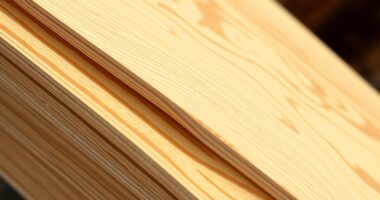To accurately estimate log weight, measure the diameter and length carefully, considering species and moisture content, since green logs are heavier. Use tools like diameter tapes or calipers, and apply species-specific density data or log rules like Doyle, Scribner, or International 1/4-Inch to determine volume. Knowing how these factors affect weight helps you plan transportation and pricing effectively. Keep exploring for tips on refining your measurements and understanding different log rules.
Key Takeaways
- Use species-specific density and measurements with formulas like Huber’s to accurately estimate log weight.
- Recognize that moisture content greatly influences weight; green logs are significantly heavier than dried ones.
- Apply appropriate log rules (Doyle, Scribner, International 1/4-Inch) for volume estimates that impact weight calculations.
- Measure diameters at both ends and along the length for reliable volume and weight assessments.
- Accurate log weight helps optimize transportation, prevent overloading, and ensure fair market valuation.
Methods for Estimating Log Weight
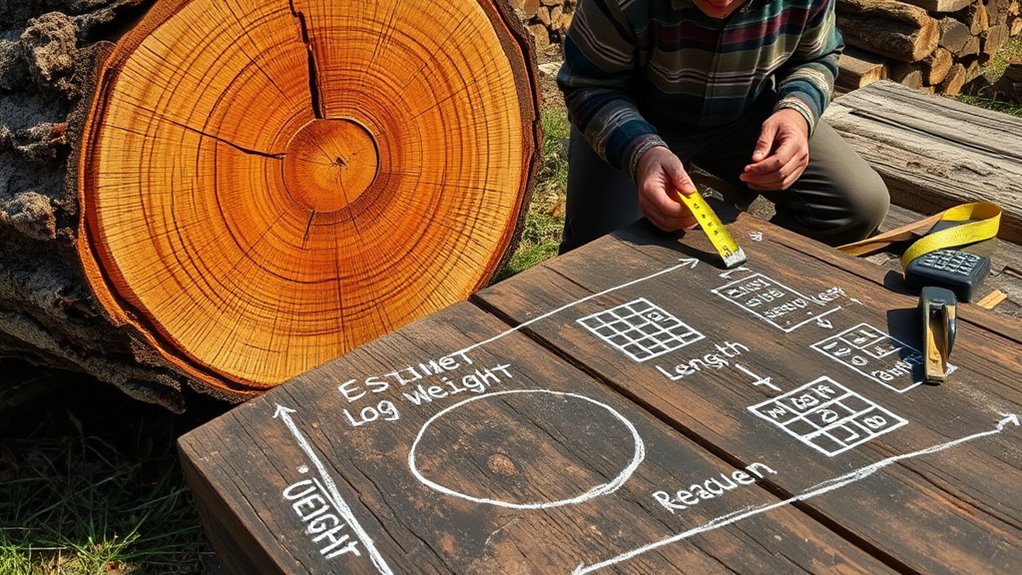
Estimating log weight accurately is essential for efficient forestry operations, and several methods help achieve this. One common approach involves using the Hubers formula, which multiplies the green density (lb/ft³) by the log volume in cubic feet. To measure the volume, you need to measure the diameter, typically at the larger end, and the length of the log. Measuring the larger end diameter provides a more conservative and safer weight estimate, especially for tapered logs. Additionally, measurement techniques such as using a diameter tape or calipers can improve accuracy in the field. Understanding the importance of species-specific density data can significantly enhance the precision of weight estimates. Log rules such as Doyle, Scribner, and International 1/4-Inch convert measurements into board foot estimates, indirectly assisting in weight calculations. By combining species-specific density data with these measurement techniques, you can quickly and practically estimate log weight in the field, ensuring better decision-making and resource management. Incorporating accurate measurement techniques and understanding wood density variation enhances the reliability of these estimates, facilitating more effective forestry practices. Additionally, awareness of regional climate effects on wood moisture content can further refine weight estimations.
Resources and Tools for Determining Timber Weight

To accurately determine timber weight, you can leverage a variety of resources and tools designed for quick and reliable calculations. A log weight calculator is invaluable, using species-specific density values along with log dimensions to estimate weight precisely. Resources like “Utilization of Hardwoods Vol. 3” and lumber weight tables provide detailed data for different hardwood and softwood species, aiding your calculations. Standard log rules such as Doyle, Scribner, and International 1/4-Inch help you convert log volume into board feet, which can then inform weight estimates. Practical tools like Excel-based calculators and mobile apps allow you to input species, dimensions, and quantity, streamlining your process. Accurate measurement techniques—like recording diameter at the small end and log length—are essential for dependable results. Additionally, understanding the Nutritional Value of Juices can be important for health considerations when consuming products derived from wood or other sources. Using species-specific density values ensures your weight estimations are as precise as possible, especially when working with different wood types. Incorporating electric tools into your workflow can also improve measurement accuracy and efficiency. Moreover, familiarizing yourself with common measurement mistakes can help prevent errors in your calculations. Additionally, understanding the vetted Halloween product reviews can offer insights into reliable tools and costumes that might be useful for themed workshops or events.
Variations in Log Weight Based on Species and Moisture Content

The weight of a log varies considerably depending on its species and moisture content. Different species have distinct densities, influencing their overall log weight. For example, hickory logs can weigh around 1267 lbs, while yellow poplar logs are about 1262 lbs. Moisture content also plays a crucial role; green logs with over 150% moisture are much heavier than dried logs with 20-25% moisture. As moisture decreases, log weight can drop 30-50%. To visualize this, consider the following:
| Species | Typical Density (lb/ft³) | Moisture Content |
|---|---|---|
| Hickory | 70+ | Green (>150%) |
| Yellow Poplar | 25-30 | Dried (20-25%) |
| Ash | 70+ | Green |
| White Spruce | 17-20 | Dried |
| Softwood | 17-20 | Dried |
Understanding these variations helps accurately estimate log weight for safe handling and transportation. Moisture content significantly impacts how much a log weighs and must be carefully considered during logging and processing. Additionally, knowing the species can assist in predicting the weight more accurately based on typical density ranges. Recognizing the density variations across different woods is essential for precise weight calculations and safe operation. Properly accounting for moisture level ensures more reliable weight estimates and prevents overloading during transportation. Moreover, awareness of industry standards can improve the consistency of weight estimations in commercial logging practices.
Practical Techniques for Safe and Accurate Load Estimation
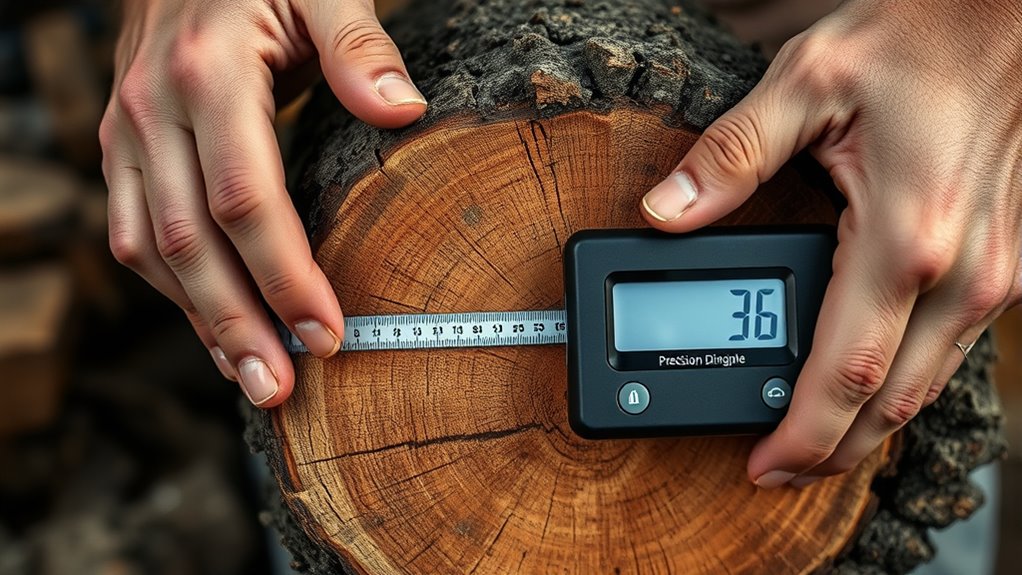
Accurate load estimation begins with precise measurements of each log’s dimensions. Measure the diameter at the smallest end to avoid overestimating volume, and record the length accurately. Use conservative volume calculations, such as measuring larger diameters or applying half-cone methods, to prevent underestimating the weight. By measuring carefully, you can better estimate the log’s weight and avoid overloads. Record your estimated weights and compare them with actual scaled loads to develop reliable rules of thumb for safe handling. Incorporating measurement accuracy can further improve your load estimations by reducing errors. Additionally, understanding knowledge of weight distribution can further enhance your ability to make safe and accurate load assessments. Paying attention to juice detox side effects and how they impact physical performance can help you plan your workload accordingly, ensuring safety during demanding tasks. Being aware of privacy policy practices related to data collection can help you better understand how your measurements and estimates are stored and used. Adjust trailer height and load distribution based on these estimates, ensuring you stay within legal weight limits. When in doubt, overestimate the weight to prioritize safety, preventing legal issues and equipment overloads during transport. Additionally, understanding lifestyle factors such as proper planning and routine checks can improve the accuracy and safety of your load estimations.
Understanding Log Rules and Their Impact on Volume Measurement

Understanding log rules is essential because they directly influence how you estimate the volume of logs, which in turn affects their valuation and handling. Different log rules, like Doyle, Scribner, and International 1/4-Inch, use distinct formulas and diagrams to calculate board feet, impacting measurement accuracy. Doyle’s rule, from 1825, often underestimates small logs and overestimates large ones. Scribner’s rule uses diagrammatic cross-sections, sometimes undervaluing irregular or longer logs. The International 1/4-Inch rule, introduced in 1906, offers a more precise mathematical estimate, leading to variations in volume calculations. These differences can cause significant discrepancies in market value, so understanding how each log scale works helps you choose the most appropriate rule for your logs. Additionally, research into sound vibrations suggests that integrating certain frequencies can enhance the accuracy of measurements by reducing errors caused by irregularities. Proper maintenance of your drivetrain components can also improve measurement consistency when handling logs. Moreover, understanding the influence of log scale differences can help you better interpret measurement results and optimize your logging operations, especially when selecting the appropriate measurement method for different types of logs.
Comparing Log Rules: Doyle, Scribner, and International 1/4-Inch
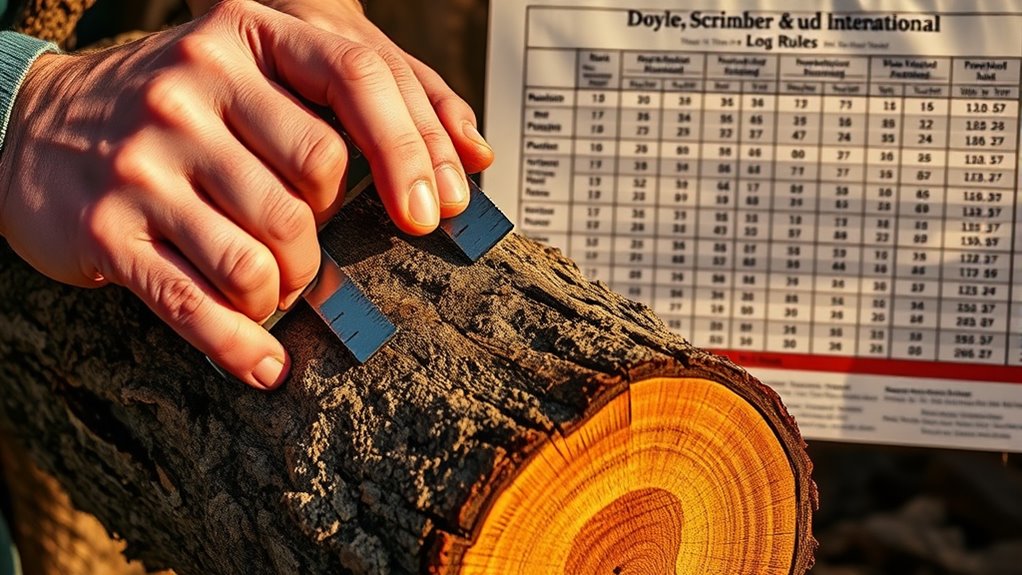
You need to understand how different log rules can lead to varying volume estimates, which directly affect market values. Doyle tends to underestimate small logs but overestimate large ones, while Scribner often undercounts irregular or long logs. The International 1/4-Inch rule offers more consistent and accurate measurements, making rule choice vital for fair transactions. Additionally, awareness of regional log volume measurement standards can help ensure fair dealings in the lumber market.
Rule Calculation Differences
When comparing the Doyle, Scribner, and International 1/4-Inch log rules, differences in their calculation methods lead to varying volume estimates. The Doyle rule uses a simplified formula that often underestimates small logs and overestimates large ones, affecting rule calculation accuracy. Scribner’s rule relies on diagram-based methods that round to the nearest 10 board feet, which can underestimate logs with irregular shapes or longer lengths. The International 1/4-Inch rule employs a precise mathematical formula, providing more consistent and accurate board foot estimates across different log sizes. For example, a 16-inch diameter, 16-foot log might be valued at 144 BF using Doyle, 160 BF with Scribner, and 180 BF with the International rule. These differences directly impact log valuation and market transactions.
Small Log Biases
Differences in calculation methods among the Doyle, Scribner, and International 1/4-Inch log rules become especially significant when evaluating small logs under 16 inches in diameter. You might notice that:
- Doyle often underestimates the volume of small logs, giving lower board feet estimates.
- Scribner uses diagram-based calculations with kerf allowances, resulting in more conservative estimates.
- International 1/4-Inch tends to provide more accurate volume estimates but can slightly overstate small logs’ true value.
These biases affect how you price and value small logs, especially since Doyle undervalues their merchantable volume. Choosing the right log rule guarantees you accurately assess small log board feet, avoiding miscalculations that could impact your profits.
Market Impact Variations
Variations among the Doyle, Scribner, and International 1/4-Inch log rules can considerably influence market prices and transaction outcomes. Each log rule provides different volume estimates for the same logs, affecting how board feet are calculated. The Doyle rule often underestimates small logs and overestimates large logs, leading to discrepancies that can shift market values. The Scribner Decimal C rule typically yields lower volume estimates than the International 1/4-Inch rule for identical logs, which can lower perceived value. The International 1/4-Inch rule is regarded as more accurate and consistent, helping stabilize market prices. These differences can cause variations of 20% or more in board foot calculations, impacting buyer-seller negotiations and overall market efficiency. Understanding these log rule variations is essential for accurate valuation and fair transactions.
How Log Weight Influences Transportation and Market Value
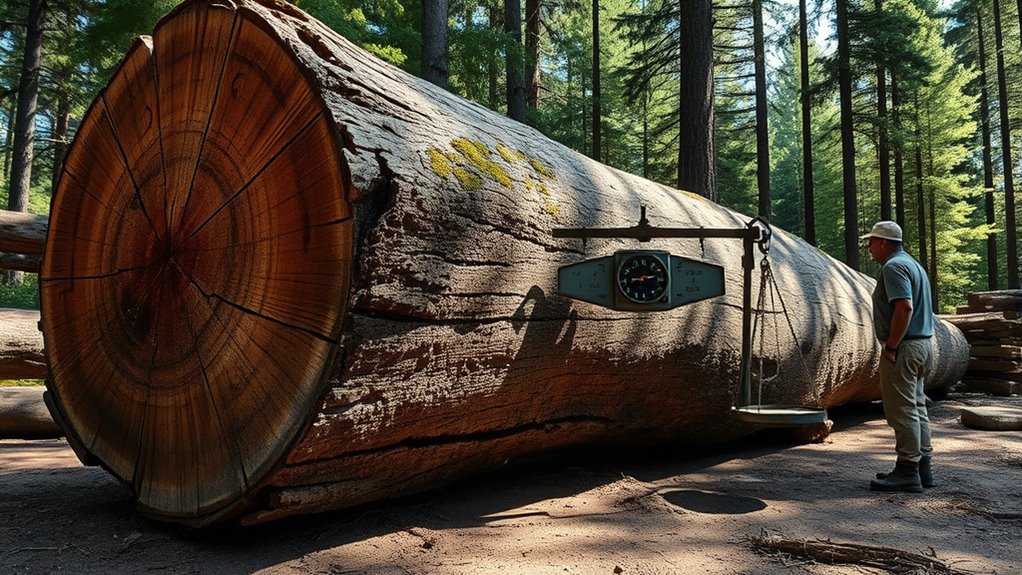
Log weight plays a pivotal role in transportation and market valuation because it directly affects shipping costs and legal compliance. If your logs are too heavy, you risk exceeding legal weight limits, leading to fines or safety hazards. Conversely, underestimating weight could result in underpayment or logistical delays. Think of it like this:
Accurate log weight ensures legal compliance, fair pricing, and efficient transportation.
- You’re estimating the load that’ll fit within a truck’s 12-ton limit.
- The species, diameter, and moisture content determine whether your logs are lighter or heavier.
- Using standard rules like Doyle or Scribner influences perceived volume and market value.
Getting an accurate log weight helps you plan efficient shipments, avoid legal issues, and negotiate fair prices. It’s essential for balancing transportation costs with market value, ensuring your timber transactions are both legal and profitable.
Tips for Improving Accuracy in Field Log Weight Assessments

Using multiple measurements and recording your data carefully can considerably improve the accuracy of log weight assessments. Comparing these measurements helps identify inconsistencies and ensures reliable estimates. Incorporating this approach into your process leads to more precise and trustworthy results.
Use Multiple Measurements
To improve the accuracy of your field log weight assessments, it’s essential to take multiple measurements along each log’s length. This helps account for taper and irregular shapes, ensuring reliable data. First, measure both ends of the log and record several diameter readings at different points. Imagine using a flexible tape to capture the smallest and largest diameters:
- Measure at the base, midpoint, and top of the log.
- Use the cone volume method for better accuracy than simple averages.
- Always re-measure after a short interval to verify consistency. By averaging multiple measurements or selecting the most conservative diameter, you reduce errors and improve your assessment’s accuracy. These practices give you a clearer picture of the log’s true size, leading to more precise weight calculations.
Record and Compare Data
Keeping detailed records of all measurements—such as diameter, length, and species—is essential for improving your estimation accuracy over time. By consistently tracking these measurements, you can identify patterns that help refine your estimates. Take multiple measurements at different points along the log to account for taper and irregularities, then average these for a more reliable estimate. Use conservative, species-specific density values from trusted tables or calculators to avoid underestimating the log’s weight. Comparing your estimated weight with actual weighings, when possible, highlights discrepancies and guides adjustments. Over time, develop personal rules of thumb based on your recorded data and practical experience. This systematic approach ensures your estimates become increasingly precise and dependable.
Frequently Asked Questions
How Does Log Shape Affect Weight Estimation Accuracy?
You wonder how log shape impacts weight estimation accuracy. The shape influences how you measure and estimate weight because irregular or tapered logs can be tricky to size accurately. Cylindrical logs are easier to calculate, but irregular shapes or those with branches and knots can lead to errors. To improve precision, you should consider shape adjustments or use tools that account for these variations, ensuring your estimates are as accurate as possible.
Can Temperature Variations Impact Log Weight Measurements?
Imagine a scale balancing on a windy day — temperature variations do the same for log weight measurements. When temperatures fluctuate, logs can expand or contract slightly, affecting the weight readings. Cold weather makes logs denser and heavier, while warmth causes slight shrinking. So, yes, temperature impacts measurements. To get accurate results, measure logs in consistent conditions or account for temperature changes in your calculations.
Are There Industry Standards for Estimating Green Versus Dry Weight?
You’ll find that industry standards help estimate green versus dry wood weights, though they vary by species and region. Typically, green weight is about 50-100% higher than dry weight, depending on moisture content. Professionals often use standardized moisture content levels—around 30% for green and 12-15% for dry—to make consistent estimates. These guidelines help you predict weights accurately, improving your woodworking projects and inventory management.
How Often Should Calibration Be Performed on Measurement Tools?
Imagine your measurement tools as the compass guiding your craft. You should calibrate them regularly to keep your course true. For most tools, check calibration at least once a year, or more often if you’re working with precise measurements or changing conditions. Frequent calibration guarantees accuracy, preventing costly mistakes and ensuring your work stays aligned with industry standards. Keep your tools trustworthy, and your projects will always hit the mark.
What Safety Precautions Are Recommended During Weight Assessment?
During weight assessment, you should prioritize safety by wearing appropriate protective gear like gloves and safety glasses. Confirm your workspace is clean and free of obstructions to prevent accidents. Use proper lifting techniques to avoid strain, and handle weights carefully to prevent dropping or damage. Keep your tools calibrated and in good condition, and always follow manufacturer instructions. Stay alert and cautious to maintain a safe environment throughout the process.
Conclusion
Understanding log weights helps you estimate loads accurately and avoid costly mistakes. While precise measurements guarantee safe transportation and fair market value, rushing the process can lead to errors. Think of the balance between effort and accuracy like weighing a log carefully versus rushing through a cut. Mastering these techniques lets you handle your timber confidently, knowing that quality and safety weigh just as heavily as weight itself.



